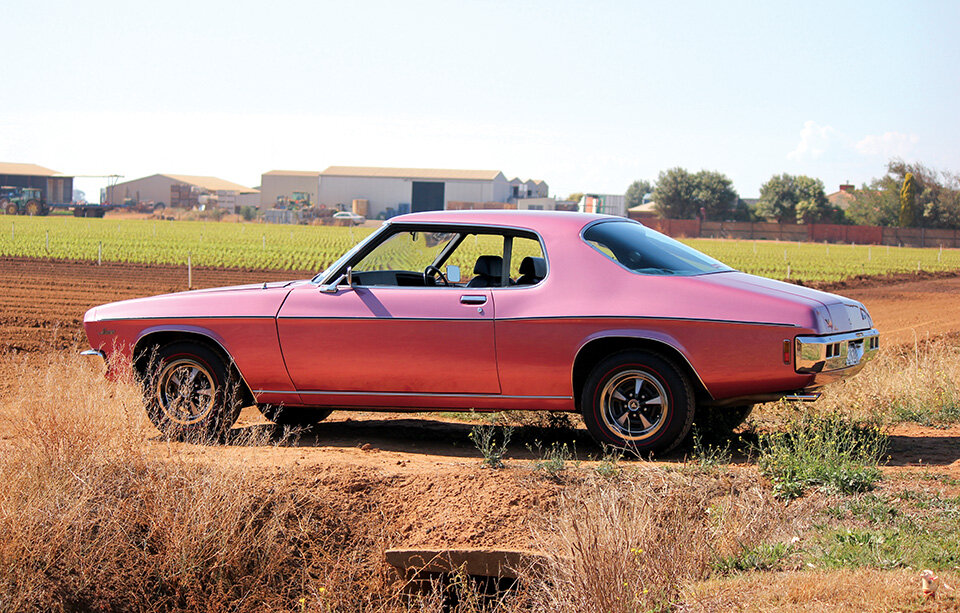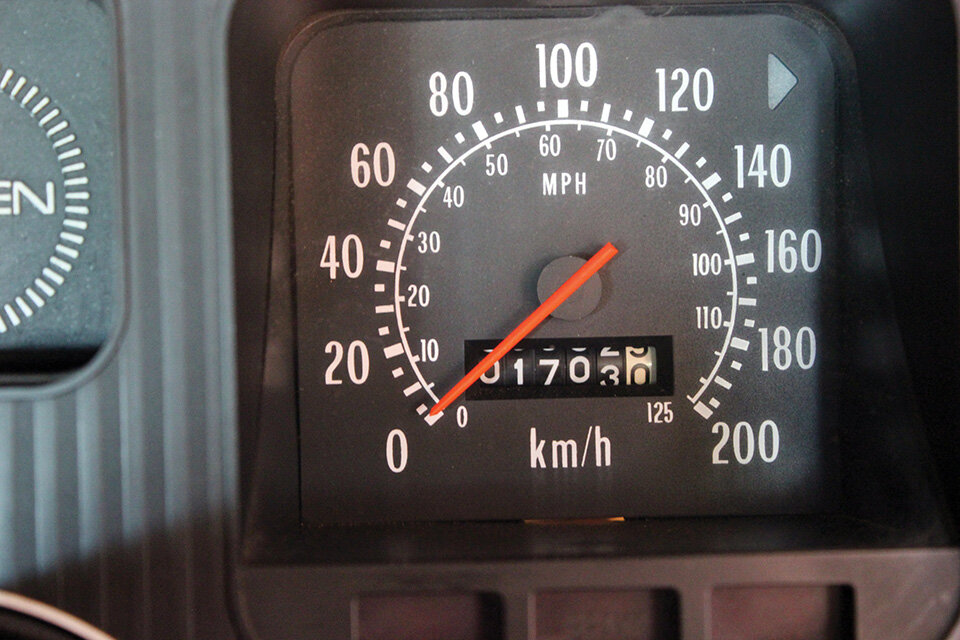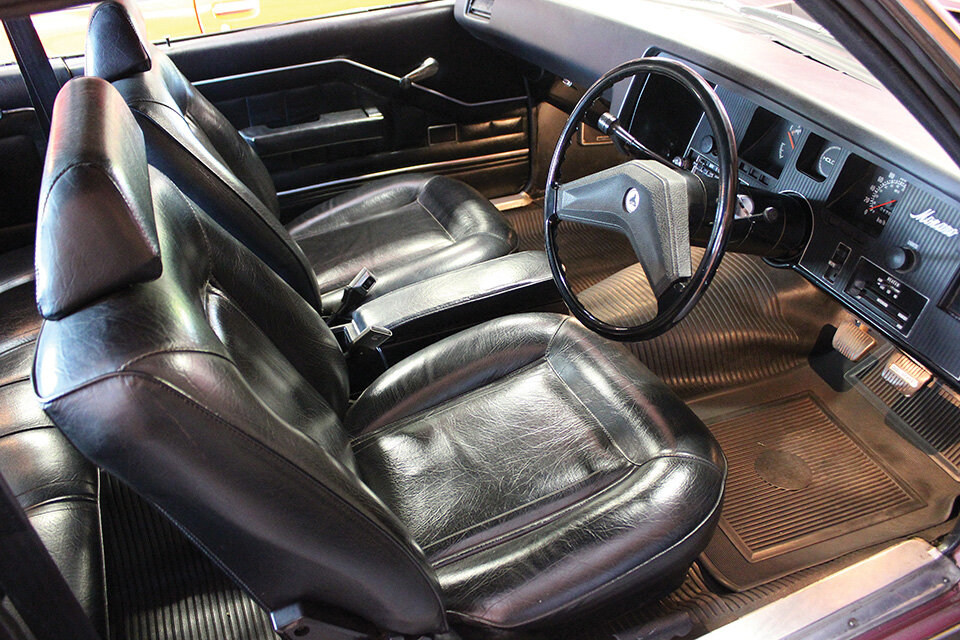3 on the tree
To find an unrestored base model Monaro is rare indeed, to find one factory fitted with a 253 three-on-the-tree in Orchid Metallic with a full ownership history is unheard of, until now…
FROM SURVIVOR CAR AUSTRALIA MAGAZINE - ISSUE #2
The word ‘Monaro’ instantly conjures up an image of Holden HK and HQ GTS coupes with all the characteristic features; the big V8 engine, 4-on-the-floor stick shift, a sports dash, plush carpet, and badges bragging big cubes with war-paint that makes them look fast just standing still. Ironically, it’s the lack of the usual list of features that makes this car a real head turner. In fact, you can accurately describe this coupe as a ‘Plain Jane’ Monaro.
The Monaro coupe was considered the sportiest model in the HQ range. To cater for a range of buyers with different budgets, it could be ordered with a variety of engine and transmission combinations starting with the six-cylinder engine mated to a three speed column shift manual all the way up to a high performance 350cid Chevrolet powered V8 and heavy duty 4-speed manual gearbox.
Raising curiosity levels and begging a closer look, there’s something about this spartan Monaro that draws the eye. Instantly you wonder who would have ordered such a beast, a V8 mated to a 3-on-the-tree manual, rubber floor mats and a bright metallic pink duco. What were they thinking?
To answer this we tracked down the original owner, a Mrs Cynthia Sellen. Cynthia grew up in the beautiful Adelaide Hills in South Australia. Her appreciation of vehicles came from, like many of us, her father. He drove a Hudson and didn’t like any of the modern day vehicles, which as far as he was concerned was anything built after 1960! Cynthia married and moved to Melbourne to begin the next phase of her life.
In 1972, Australia was going through a huge social and cultural change. The country had just come out of 23 continuous years of conservative governments. The new Labor government was progressive and in a hurry to get things done. The Whitlam government set up community health centres, established legal aid, introduced Medibank, made University education free and advanced the cause for gender equality and aboriginal rights. ‘It’s time!’ was the Labor party’s catch phrase. There was a feeling that Australia was finally breaking free from a boring and conservative era and everyone under the age of 40 wanted to jump on board!
Unfortunately the federal government encountered some rough waters. In October of 1973 the world wide oil crisis hit sending Australia into an economic slump by mid-1974. The inflation rate in Australia, that is how much goods and services increase in price over a year, hit a high of 13 percent before peaking at about 17 percent by mid 1975!
Early in 1973, the then 32 year old Cynthia, could not have foreseen these tough economic times just around the corner. She was living in Deer Park an outer western suburb of Melbourne and was an avid Holden and Peter Brock fan. She worked in finance, loved music (especially Rock’n’Roll) and was also into ballroom dancing at a professional level. Cynthia’s daily driver was a battled scarred EH Holden station wagon. Her husband, Peter, was driving a white HQ Kingswood sedan which was subsidised by his employer. When Peter was promoted, his new salary package now included a company car. Thus, they decided to trade in the white HQ sedan for a brand new car for Cynthia.
Being particularly impressed with the Bathurst winning Monaros of 1969 and a then young heart-throb Peter Brock, her new car was always going to be a Holden. Cynthia decided that the new sporty looking HQ Monaro GTS coupe would do her just fine. Although the Monaro GTS was the top of the range, she understood that with a mortgage and other financial commitments she would have to settle for a more basic standard model. “Win on Sunday, sell on Monday” was the marketing catch cry back then, with buyers flocking to get into performance cars. Much like today, Holden fans stayed loyal to the brand.
Cynthia and her husband Peter drove across to the Kevin Dennis Holden dealership in Braybrook, a few suburbs away to see what was available. Kevin Dennis had some great offers on at the time such as HQ Kingswood sedans for $3,199 (see newspaper ad, below left) and with their still new HQ Kingswood as a trade-in they knew they could strike a great deal. They found the car salesman a pleasure to deal with and “not pushy at all”. The dealership only had one HQ Monaro coupe in stock, a 6-cylinder but Cynthia wasn’t sold on it.
Peter suggested they should buy a V8 Monaro. The main reasons for this decision were that petrol prices were of no real concern back then (the oil crisis hadn’t hit yet) and they would get a longer life out of a V8 engine than a 6-cylinder. Cynthia agreed as long as she chose the colour. She carefully studied the colour charts and soon realised that she didn’t like any of the popular colours. Finally she settled on an unusual but striking colour which caught her eye, a pink known as Orchid Metallic.
It’s no surprise that Orchid Metallic was Holden’s least popular colour in the HQ model range, especially for Monaros. To many this colour was just plain ‘pink’. Not really a colour you’d associate with a sporty muscle car like the Monaro! Even the original certificate of registration document states the colour as pink. After a two month production wait, Cynthia’s pride and joy was picked up on Monday the 30th of April, 1973.
When the Monaro was first introduced with the HK model, GM-H banked on a higher public demand for the base model six-cylinder models. How wrong they were! In fact the GTS was what everyone really wanted. As a result production stalled as it was difficult to clear the plant stock of base model Monaros. The numbers of base model Monaros built after release is very low to the point that the overall total was nowhere near the forecasts. A similar situation occurred with the HQ but because it was the longest model run, there were more base model HQ Monaros built than in previous model runs but the ‘80437’ – as on our Orchid Metallic car – is still a rare beast. So what exactly is an 80437 Monaro? Decoded, ‘80437’ stands for a base model V8 Monaro with a 3-speed manual column shift.
This Orchid Metallic 80437 Monaro was specifically ordered and built with a 253cid V8 engine and a 3-speed manual column shift. Why a column shift 3-on-the-tree, especially behind a V8? Cynthia tells us that the choice was made because she was more comfortable driving a column shift and didn’t want to learn how to use a 4 speed floor shift. You see, her previous car, the EH Holden also had the 3-on-the-tree column shift. The other logical reason behind her choice was that she found it difficult to reach the floor shift. In fact, an article on the then new HQ Monaro in ‘Motor Manual’ from February 1972 also points out this same fault stating that ‘poor placement of the shift lever ruins the Monaro’s interior layout’. Cynthia says “It took me a while to get used to the extra power of a V8 compared to the EH Holden I was driving”. She always referred to the Monaro as ‘her little car’.
In ordering a V8, the front brakes had to be upgraded to discs. The Monaro also had a dealer fitted towbar, rear air shock absorbers and mudflaps, but no radio. Her husband was a sales representative for Astor Records, he was able to source a state of the art 8-Track tape player at a wholesale price. He fitted this when the car was less than twelve months old.
Base model Monaros like this Orchid beauty, came with stock steel rims and ‘dog dish’ hubcaps. Sometime in the late 1970s Peter fitted a set of ‘Hotwire’ mag wheels which were all the rage. Yep, just like today, fitting aftermarket wheels was popular even back then.
To say that Cynthia was very pedantic about her Monaro is an understatement. Fitted seat covers always protected the front seats and no one ever sat in the back! Her husband Peter was also handy with a spanner and loved to tinker with cars. He carried out all the regular servicing which is why only the 1,500 kilometre service is stamped by the Holden dealer. The tow bar was only fitted as a ‘just in case’ item and was used sparingly to tow a small 6 by 4 foot trailer.
Cynthia’s ‘little car’ spent the next 17 years being driven to and from her workplace, a daily round trip of around six kilometres. In fact, Cynthia worked at Massey Ferguson (a tractor manufacturer) from 1960 until 1980 which is probably why she was able to secure some special treatment for her Monaro. You see, it was always parked in a secluded yard around the back, away from the congested main car park.
Apart from the daily trip to work and back, the Monaro’s longest trip was to Cynthia’s hometown of Adelaide twice. She told us that her car has never been involved in an accident, and it shows. Every panel is the original from the factory, and is dead straight with good but not perfect paintwork. At some stage in the late 1970s Peter decided that he too wanted a Monaro and so he bought a gold HK six-cylinder. Cynthia laughs and tells us that they were well known for the couple that owned ‘His’ and ‘Hers’ Monaros. Apart from immediate family and the odd neighbour, very few others knew about their Monaros as she lived at the bottom of a quiet cul-de-sac.
In 1990, Cynthia’s husband purchased a brand new VN Commodore which she still drives today. The Commodore is also extremely well cared for and has clocked up just 120,000km in the last 20 odd years. Another possible future Survivor if the preservation of the Monaro is anything to go by.
In 2008, a few years after her husband Peter had passed away, Cynthia required the services of a plumber. When he arrived his attention was immediately drawn to the metallic pink Monaro in the garage. He mentioned to Cynthia that he had a friend who would be very interested in buying the Monaro if she would consider selling. In her late 60s, she knew that eventually the time would come to part company with her beloved Monaro. Although it deeply pained her, Cynthia had hardly used it in years. She was determined though that it would only go to someone who would maintain and appreciate it the same way she had done. She especially did not want it to go to anyone that would modify it. Cynthia told the plumber that yes, she was prepared to sell.
The plumber’s friend, Ross, was there in a flash. Ross says that Cynthia was a tough negotiator and in fact she didn’t actually negotiate at all! She knew exactly what the car was worth and she didn’t budge one bit from her asking price. Take it or leave it, that was her price. There was however one other last hurdle. Ross was also on the receiving end of a pretty tough inquisition. Cynthia wanted to know exactly what Ross’ future plans were for her Monaro. Only when she was satisfied that her beloved Monaro was going to a good home did she finally let go. With a tear in her eye, after 35 years years together the Monaro was driven out of Cynthia’s life. After it was sold, it took months for Cynthia to come to terms with the fact that the Monaro was gone. Everytime she looked in the empty garage, she became sad and teary. She was still very emotional when she told SCA her story. We offered to reunite her with her old Monaro but she declined, feeling the ordeal would be too emotional.
Ross couldn’t believe what he had bought. The ‘pink’ Monaro was a true Survivor. “Mate, it’s an unrestored original in mint condition. To boot it’s a 253 with a 3-on-the-tree. Rare as hen’s teeth!” exclaimed Ross. Registering it in his name (it passed the roadworthy check with flying colours), Ross had planned to buy the Monaro as a keeper and enjoy driving it on weekends. His house was undergoing renovations at the time and so there was ‘crap’ all over the backyard and in the garage so the Monaro would have to be kept elsewhere. He organised for the car to be stored in a friend’s garage. Unfortunately the friend passed away and the house was sold. The ‘Minister of War and Finance’ (Ross’ wife) reminded him about the cost of the renovations. This combined with the fact that he couldn’t keep the Monaro at his place because it would only be a matter of time before it was accidentally damaged with all the workmen coming and going. So, after only owning it for nine months and driving it less than ten kilometres, Ross decided that the best thing to do for the sake of his Monaro was to sell it.
The Monaro was advertised on eBay under the simple heading “HQ Monaro V8, manual”. This brief description did not do the car justice. Nevertheless, the Orchid Metallic Monaro was spotted and snapped up by a keen eyed buyer, Steve the third owner, by pressing the Buy-it-Now option. In fact, it had only been advertised for four hours before Steve had made his move.
When Steve went to pick up his Monaro, he knew right away he had found something special.
Up close & intimate
This base model Orchid Metallic Monaro is certainly a rare gem and must be one of the very few left, a real Survivor. Today, the car presents pretty much as it left the Kevin Dennis dealership back in 1973. There are a couple of small dings on the front bumper but overall it’s a well maintained example, a tribute to the original owner.
The body protector side mouldings are factory fitted and look virtually brand new still. Close inspection reveals that all the glass and the Lucas headlights are still the factory fitted originals. A set of period correct GTS Monaro styled steel wheels have been fitted. The ‘Hotwire’ mags have been tucked away in his garage. A non-original left hand mirror had been fitted sometime in the 1970s by Cynthia’s husband, probably as a towing aid.
The current proud owner, Steve, and his son Matthew.
The engine bay can only be described as unbelievable. Almost every item is factory fitted apart from the brake master cylinder and distributor leads. Still, the brake master cylinder was replaced with a NOS (New Old Stock) item and displays the correct build code stamped into the housing. Spark plug leads are period reproductions stamped with the correct GM part number. It is also impressive to see the original ‘clamp style’ battery terminals still intact, given many have been replaced with aftermarket ‘bolt-through’ type terminals. The water pump is also original and this is evident from the single water inlet. Aftermarket water pumps have two water inlets so you can easily pick a non-original one.
This Monaro coupe is a series II or ‘update’ HQ, which was introduced in March of 1973. Slight changes included amber indicator lights, park lights in the main headlight, a speedometer that now read in km/h instead of mph and front bucket seats which had no stitching inserts. The interior flooring consists of simple rubber matting and a basic instrument cluster with the bare necessities; a speedometer and a fuel gauge! The front seat belts are inertia reel, the rear are standard ‘lap-sash’ type. Being a base model Monaro, there are no rear armrests (not that his Monaro has ever had rear passengers anyway). The boot area is still as it left the factory floor, adorned with the original rubber boot mat and the standard spare wheel.
A few years ago, Steve displayed his vehicle at the Monaro Nationals. Much to his delight, his Monaro drew a huge crowd and generated a high level of interest. It won 2nd place in the ‘People’s Choice Award’ having been beaten by a fully restored Monaro, go figure! The Monaro Nationals now have a separate category for original unrestored and Survivor cars. When Steve purchased the Monaro it was just shy of showing 100,000 kms on the clock. Although it pained him to clock it over the ton, he decided the car should be driven and enjoyed.
The unusual combination of the 253cid V8, the 3 speed manual column shift and the Orchid Metallic paint add to this Monaro’s rarity and appeal. An original car with a very unique ‘Wow’ factor indeed. Many of these lower end Monaros had their engines and transmissions ripped out and transplanted with high performance 308cid and 350cid V8s, and M21 4-speed or Turbo 400 automatic transmissions. Many more base model Monaros were turned into highly modified Street Machines sporting custom paintjobs, blown big block V8s fitted with Ford 9-inch diffs. The simple fact that this Monaro was meticulously maintained by the original owner who set strict guidelines as to who would be the next caretaker, ensured it has remained in original condition today. A genuine Survivor.
With sadness and regret, Cynthia says, “I still miss my little car”. We can understand what she means. She ordered her Monaro just the way she wanted, and it was an integral part of her and her husband’s life for half a lifetime. The current owner Steve, reassures us that he is a worthy custodian and endeavours to maintain the Monaro with the same deep passion Cynthia had. What’s more Steve’s son, Mathew, also has a passion for the Orchid Metallic Monaro and appreciates its originality. We are sure this Survivor will be in very good hands for many years to come.
SCA would like to acknowledge Cynthia for generously sharing her story with us. We would also like to thank Ross the second owner, as well as Steve and his family for allowing us to tell the story of this unusual Monaro.







